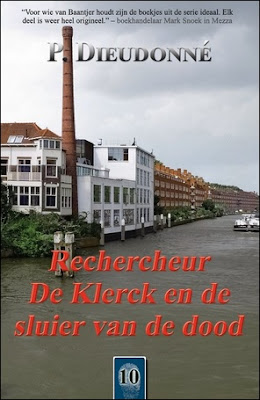Five years ago, P. Dieudonné debuted with Rechercheur De Klerck en het doodvonnis (Inspector De Klerck and the Death Sentence, 2019) and since Dutch politieromans (police novels) à la A.C. Baantjer are as a rule shortish novels, Dieudonné has written two novels every year since then – even updating the tried and tested Baantjer formula. So what happened to the first of two releases of 2024 that should have been out for months now?
Rechercheur De Klerck en de sluier van de dood (Inspector De Klerck and the Veil of Death, 2024) is the tenth entry in the Inspector De Klerck series and, to mark this milestone, E-Pulp Publishers told Dieudonné that "the tenth book could be a bit thicker." The delay was due to Dieudonné having to write a longer novel and was very curious to see what was done with the roughly hundred extra pages. Was it going to be a police-thriller with a hunt for a serial killer, another impossible crime extravaganza like Rechercheur De Klerck en de ongrijpbare dood (Inspector De Klerck and the Elusive Death, 2020) or returning to the first novel with a homage to Baantjer? However, the "most complicated case" in the careers of the inspectors Lucien de Klerck and Ruben Klaver turned out to be something different altogether.De Klerck and Klaver, of the Rotterdam police, are called to a thrift store where a gruesome discovery was made inside a newly arrived, secondhand freezer.
A customer who wanted to inspect the freezer found the battered, partially dressed body of woman inside who bears a striking resemblance to Marilyn Monroe, but no identification, phone, money or jewelry – except for the red dress used to cover the body. The red dress is identified as an abaya that came with a hijab or veil. De Klerck notes that "both garments formed a dissonance in her appearance" as the victim's resemblance was deliberate. Right down to a cheek tattoo to replicate the tiny pigment spot. But without a name or solid clues as a starting point, De Klerck and Klaver turn their attention to the freezer.
The freezer was donated by Emir's Ice Palace, but the owner, Emir Çelik, denies any involvement ("it's not my habit to hide corpses in freezers") or knowing the victim. But when they go over CCTV footage of the ice salon, they see a veiled woman reasonable fitting the description of the victim enter the salon. And going to the backroom like she had done it before. Almost like she belonged there. Only she never came out. The old freezer was standing out back, waiting to be picked up, which can only be reached by a boat. So things begin to look grave for Emir Çelik when De Klerck and Klaver learns his marriage is going to rough patch. Zeynep Çelik has left their home and taken a room in Hotel Hollywood, "each room inspired by one of the major productions from Hollywood's Golden Age," which provides them with another lead. The hotel security footage shows the veiled lady going into the hotel with luggage and leaving without it, but why did the hotel denied she was a guest?
De Klerck and Klaver peddle between the hotel and ice saloon as the complications and contradictions pile on to the very end, which once again shows Dieudonné has knack for spinning a good deal of complexity out of ultimately simple situations and sordid crimes. I can't divulge much more about the plot details without spoilers. So let's take a different track to round down this review.
In many ways, Inspector De Klerck and the Veil of Death is a typical Dutch politieroman as formulated by Baantjer. A style of crime fiction a little bit different from the customary detective novels and police procedurals, because they tend to be more about what-happened-and-why than who and how – former decides how much of a sway the latter has over the plot. That's why you won't find many impossible crimes, dying messages or unbreakable alibis in the novels by Baantjer and his many imitators. Generally, they try to keep things clear, uncluttered and readable without too many unnecessary complications like locked rooms or dying clues. Last year, I returned to Baantjer by rereading one of his late period novels and one of the comments said it book sounded fun, but probably out of their wheelhouse. Fair enough, especially for the detective fans who follow this blog. After all, we're an eccentric lot who have certain demands when it comes to the plot.
Practically everyone who tried to be next "Baantjer" only copied his style with a few tweaks and cosmetic changes, but Dieudonné is the first who took the formula and developed it further. Such as loosening the tight formula, depicting the world of today and injecting some sorely needed plot complexity. I've said this before in previous reviews, but Baantjer never could have written, or plotted, novels like Inspector De Klerck and the Elusive Death and Inspector De Klerck and the Veil of Death. Inspector De Klerck and the Veil of Death pleasingly creates "an endless labyrinth of possibilities" out of very simple complications. Not what I expected from the tenth, double-sized De Klerck novel, but neither am I complaining and it's always a special treat to read mysteries with substantial plots in my own language. So imagine how pleased I'm with this excellent series as a whole. Just needs another locked room-centric novel with a meaty impossible crime plot to continue this run of success! :D
So, in closing, Dieudonné is the pupil who surpassed the master and hope it won't take forever for the rest of the country to catch on. Until then, I look forward to the eleventh outing of De Klerck and Klaver. Fingers crossed it will be out before the end of the year!


No comments:
Post a Comment